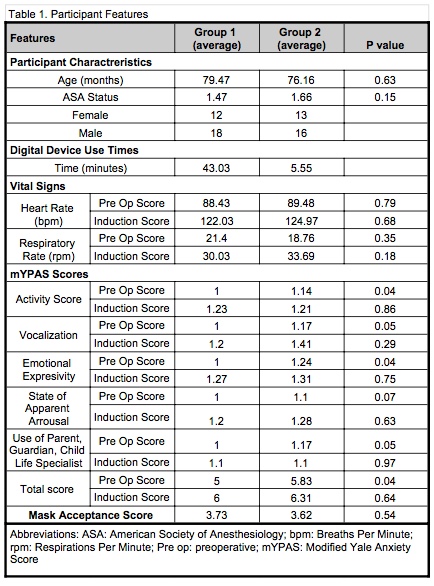GA1-46
Digital devices facilitate induction of anesthesia in children - does timing matter? A randomized trial:
Kale R, Fei C, Liu F, Passi Y, Kaplan I, Lozito R, Resti J, Smallman B
SUNY UpState Medical University, Syracuse, NY, United states
Introduction: This study evaluated the optimal time to introduce a digital tablet device to facilitate mask acceptance for induction of general anesthesia (GA) in pediatric patients. Use of digital devices has been shown to be more effective than midazolam in pediatric patients undergoing surgery1. We hypothesize that distraction devices are most effective when used for a shorter duration, and that children will lose interest after 10 minutes, exhibiting tolerance to the device.
Materials & Methods: In this randomized trial participants were assigned to 2 groups. One group received a digital tablet device for >10 minutes and the other for <10 minutes prior to mask induction. 62 participants were recruited and of these, 32 were enrolled to group 1 (>10 mins) and 30 to group 2 (<10 mins). All participants were aged 1-10 years, American Society of Anesthesiology physical classification Status I or II, presenting for elective surgery, had no developmental delay, had no mask induction within one year and received no pharmacologic anxiolysis. Participants were given a digital tablet device and allowed to choose a game or movie of their choice. Participants underwent a preoperative anxiety evaluation with the modified Yale Preoperative Anxiety Scale (mYPAS). Digital device use was then continued throughout mask induction at which time a second mYPAS assessment was completed. A mask acceptance score was also assigned to each patient ranging from 1 (great resistance) to 4 (no resistance). Analysis of multiple variables was carried out as seen in table 1.
Results: Participant characteristics (p>0.05) and mask acceptance score (p=0.54) were similar between the groups. Total mYPAS preoperative anxiety score was found to higher among group 2 (p = 0.04). The mYPAS subcategories showed preoperative activity and vocalization scores to be higher among group 2 (p = 0.04)
Discussion: Digital devices are useful tools for reducing anxiety and our aim was to determine optimal timing to be most helpful with mask acceptance. The data is suggestive of overall decreased anxiety levels when the device is introduced >10mins prior to induction. The timing of introduction had little impact on the mask acceptance or intraoperative anxiety scores. We did not achieve statistical significance for improved mask acceptance but overall data suggests their usefulness.
Conclusion: The data is suggestive of overall decreased anxiety when a digital device is introduced >10mins prior to induction. With regard to facilitating mask acceptance for GA there was no difference found in the timing of introduction.
References:
1. Seiden SC, et al. Tablet-based Interactive Distraction vs oral midazolam to minimize
perioperative anxiety in pediatric patients: a noninferiority randomized trial. Paediatr Anaesth.
2014 Dec;24(12):1217-23
2. Kain ZN, et al. The Yale Preoperative Anxiety Scale: how does it compare with a “gold standard� Anesth Analg. 1997 Oct;85(4):783-8
Top












